Decision Making Processes And Strategies
INTRODUCTION
In the contemporary business environment, the success of an organisation is highly correlated with the appropriateness of the decision-making process. This is because management has to consider several facts and figures for taking appropriate decisions as per distinct business requirements such as solving of different business issues, expansion of the company, assessing new market opportunities, etc (Potočan, 2017). This report is going to investigate different aspects of the decision making process and examines different alternatives which are considered by the management for improving overall business efficiency, including psychology dissertation help. In this context, this report evaluates different tools and approaches for business decision making.
It helps business entity for Better Utilisation of Resources. This is because decision making assists management in order to utilise the available resources for the attainment of objectives of the firm. These resources include Men, Machines, Money, Materials, Methods as well as Markets. It assists managers for optimum utilisation of a range of resources.

An appropriate decision-making system helps business entity for facing and tackling new problems and challenges (Chisholm, 2017). By taking quick and correct decisions, an organisation can manage various business issues and accept new challenges.
It provides the basis for Business Growth. This is because an appropriate business decision making ensures quick and correct decision associated with the utilisation of the resources. It helps business entity for managing business operations as per the market challenges (Janssen, van der Voort and Wahyudi, 2017). It determines a path for assessing the business objectives. By using appropriate business decision-making process, top managers are able to establish a link between business practices and current market trends.
The primary objective of a business decision is to help the organisation for achieving all its objectives quickly. Therefore, business decisions are made by analysing and evaluating all the alternatives as per the requirement of the objective.
This system supports business for increases the efficiency of business (Collier, 2015). Business Efficiency is termed as a relation between business returns and cost of operations. If the returns are high and the cost is low, that shows higher efficiency. Rational decisions result in higher returns at low cost which is having a direct impact on overall business goals.
It facilitates innovation within business operations. It helps in developing new ideas, new products, new practices, etc in order to achieve business goals. It influences innovation that would provide a competitive advantage to the organisation.
Business decision-making process assists managers in human resource management. It motivates employees (Rajasekaran and et al., 2016). Rational decisions have played a role in motivating employees. This is because highly motivated staff members are essential for the growth of the business entity. This approach provides financial and non-financial benefits to the employees.

Some important features of the effective business decision are mentioned below: It leads to a positive impact on others Good decisions are replicable It fosters new business opportunities It considers views of all individuals Good decisions are executable. It must be systematic. These decisions must be accountable. It is pragmatic as per different business requirement. For ensuring the effectiveness of the business decision-making process, business entity or decision-makers should have to consider the features mentioned above (Greasley, 2017). These features will be found very effective in handling different business objectives and operations.
For ensuring appropriateness of business decision, top management of an organisation has to consider a systematic process of decision making. This process assists managers in controlling different elements that are essential in management decision. For this purpose, different stages of management decision are evaluated below:
Identify the decision: The first step of the decision-making process is to recognise the problem or business opportunity in which the business entity needs to take an appropriate decision (Kahraman, Onar and Oztaysi, 2015). These decisions are weather associated with customers or employees perspective.
Gather information: The second stage of the decision-making process is to gather information. This is because appropriateness of decision is mainly influenced by the reliability of facts and data that have been acquired for management decision. In this stage, top management examines a variety of data such as needs of customers, business goals, current market trends, business practices etc. that are essential for attaining long term business goals.
Identify alternatives: Once you have a clear understanding of the issue, it is time to identify the various solutions at your disposal (Thirathon, Wieder, Matolcsy and Ossimitz, 2017). It is likely that you have many different options when it comes to making your decision, so it is important to come up with a range of options. This helps you determine which course of action is the best way to achieve your objective.
Weigh the evidence: The third stage of the decision-making process is the assessment of business alternatives. This section is focused on evaluating the feasibility, acceptability and desirability of different alternatives that are suitable for different business decisions (Qin, Liang and Wei, 2017). In this section, managers need to be able to weigh the pros and cons and then will select the best option that would provide the best benefit to the business entity. It may be helpful for the attainment of objectives.
Choose among alternatives: In this stage, the decision maker examines risk factor in various business decision or alternatives. Furthermore, the evaluation of a wide range of information is carried out with reference to the potential risk factor. After analysing a range of facts and figures, management selects the best alternatives.
Take action: This section of the decision-making process defines a plan for implementation. In this stage, decision makers create a plan for analysing different facts and figures along with their implementation in the business decision-making process (Bohler, Krishnamoorthy and Larson, 2017). This involves identifying different resources which are required along with assessing the support from employees and stakeholders. Getting others on board with your decision is a key component of executing the business decision. It also assists managers for the attainment of long term business goals.
Review the decision. It is termed as the last stage of the business decision-making process. In this section, the effectiveness of the business decision is examined with reference to outcomes of alternative management decision (Hair Jr and et al., 2015). This section supports enhancing the effectiveness of business decisions.
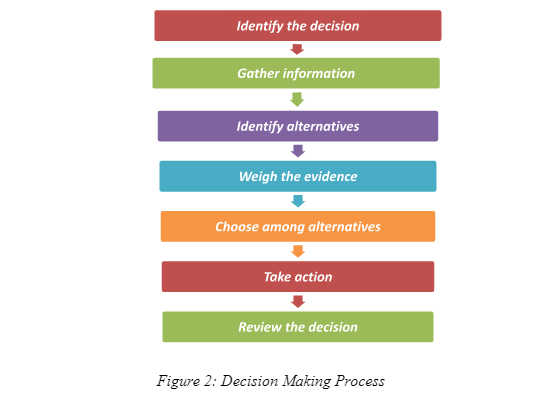
Decision matrix: In the context of business decision making, the approach of the decision matrix is being used to evaluate different option in the management decision. By using this matrix, this tool creates a table of all possible options in the first column and all other the factors that would affect the management decision in the first row. In addition to that decision maker provides the score to each option as well as weigh as per the importance (Foster, O'Reilly and Dávila, 2016). A final score is prepared for revealing the best option by calculating different scores.
T-Chart: The approach of T-chart plays a critical role in business decision-making process. This chart is being applied when weighing is carried out by using plusses and minuses of the options. This chart provides assurance that all positive and negative aspect of each business decision must be considered in the decision-making process (Macaulay, 2018).
Decision tree: In the process of business decision making, the decision tree is termed a graphical presentation that contains contemplating each option along with outcomes of each alternative. In addition to that this system also supports in Statistical analysis as per the requirement of management decision.
Motivating: This tool has found very effective when multiple people are involved in the decision making process (De Maio and et al., 2016). It has found it very effective for converting a large list of decision options to a smaller list for taking the final decision.
Pareto analysis: This approach is being termed as a useful tool for an organisation in which an organisation needs to take several business decisions. This helps in prioritising the decision alternatives so as management is able to select the best options as per priorities of an organisation.
Cost-benefit analysis: This technique is used to analyse the economic perspective of a business decision (Barlett, 2016). In this approach, decision makers examine the financial implications of different projects and decision alternatives that are playing a critical role in the selection of decision.
In the contemporary business environment, an organisation uses different decision tools for analysing the appropriateness of business decision. It assists managers in analysing various facts and figures for the attainment of long term business goals. For this purpose, the application of different decision tools is evaluated below:
Product planning: Gerber Products, Inc. is being addressed as a well-known organisation for baby products. In this regards, the management of the company has recently considered decision tree analysis for deciding whether an organisation will continue using the plastic that is known as polyvinyl chloride or more commonly used PVC (Bagozzi, Sekerka and Sguera, 2018). The main reason behind the occurrence of this situation is that a number of organisations such as environmental group Greenpeace, the U.S. Consumer Products Safety Commission, etc. have influenced companies for consideration of eco-friendly products and raw material for manufacturing eco-friendly toys and other things.
Business structuring: In the context of business structuring, the management of Tesco has considered several strategies for improving business performance and efficiency (He, Wang and Akula, 2017). For this purpose, Tesco has considered the decision tree model for examining different options for implementation of changes in business operations because companies have addressed huge competition with various other retail companies along with a reduction in sales. In this context, the approach of decision tree assists managers in the selection of best alternatives.
Cost-benefit analysis: Volkswagen is a leading car company. For enhancing the effectiveness of the manufacturing process, the company is focused on adopting new technologies in the production process (Wheelen, Hunger, Hoffman and Bamford, 2017). Therefore, the company has adopted the cost-benefit analysis for evaluating the cost of new technologies along with their benefits for the company. It plays a critical role in improving the efficiency of the overall production process.
Marks & Spencer (M & S) is termed as a leading retail chain in the UK. Marks & Spencer has considered various strategies for facilitating the best experience to customers. The company is operating several stores in the UK. For offering the best experience to customers, the management of M & S is focused on updating its Electronic Point of Sales systems in all the stores. By using the new system, staff members of the retail company are able to increase speed and efficiency of services within stores (MARKS & SPENCER SELECTS TRUE TO DRIVE DIGITAL INNOVATION AGENDA, 2018). This new system will be found very effective for facilitating the real-time data about the sales of stores with reference to inventory. For this purpose, Marks & Spencer is looking for new touch-based Point of Sales (POS) system that must contain 15-inch display with multi-touch, Intel i5 processor, 4GB DDR3 RAM, Intel HM76 Chipset and 250 GB storage. For replacing different POS system, Marks & Spencer has considered top 5 POS manufacturing firms and the best option will be considered by management.
IDENTIFICATION OF DECISION PROBLEM
Marks & Spencer (M & S) is termed as a leading retail chain in the UK. Marks & Spencer has considered various strategies for facilitating the best experience to customers. The company is operating several stores in the UK. For offering the best experience to customers, the management of M & S is focused on updating its Electronic Point of Sales systems in all the stores. By using the new system, staff members of the retail company are able to increase speed and efficiency of services within stores (MARKS & SPENCER SELECTS TRUE TO DRIVE DIGITAL INNOVATION AGENDA, 2018). This new system will be found very effective for facilitating the real-time data about the sales of stores with reference to inventory. For this purpose, Marks & Spencer is looking for new touch-based Point of Sales (POS) system that must contain 15-inch display with multi-touch, Intel i5 processor, 4GB DDR3 RAM, Intel HM76 Chipset and 250 GB storage. For replacing different POS system, Marks & Spencer has considered top 5 POS manufacturing firms and the best option will be considered by management.
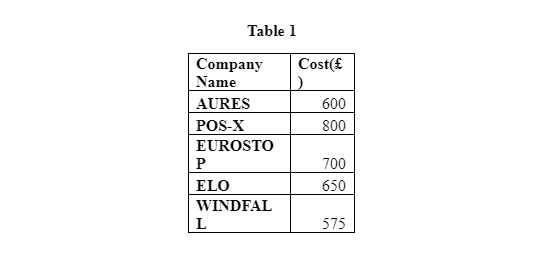
For the replacement project of Marks & Spencer, the company has accepted the proposal from the top Point of Sales (POS) manufacturing companies. These companies offer different kinds of Point of Sales (POS) machines that are having a distinct price range and distinct design (Baker, 2018). For example POS-X offers high-performance POS machines with great design, but the price of these machines is significantly higher than other POS machines. On the other hand, the speed of WINDFALL machine is comparatively other firm, but it offers low speed with less safety (Potočan, 2017). Therefore, it is critical for the business entity for the company.
SMART ANALYSIS: MULTI CRITERIA DECISION MAKING
In the context of the business decision-making process, the approach of Simple Multi-Attribute Rating Technique (SMART) is playing a critical role for analysing several facts and figures in the decision making process. Edwards firstly introduced this approach in 1971. It helps managers in the selection of the best alternative from various options (Chisholm, 2017). This approach also determines the favourable position of the company through a selection of best approach is carried. In this context, different elements of the SMART approach are examined below:
The decision maker is termed as the most important element of the business decision-making process. The decision maker for the present case is Marks & Spencer (M & S). For improving the speed of service rendering process, M & S needs extremely fast POS machines with a unique design.
The management of Marks & Spencer has considered the top 5 manufacturers of the Point of Sales (POS) by examining different attributes and features of the different brand. M & S is managing business operations from several years so as the company has appropriate knowledge about the cost of machines along with additional expenditure that could be occurred with purchase such as installation cost, warranty etc (Janssen, van der Voort and Wahyudi, 2017). In this context, below-mentioned table is showing the cost of POS machine of each company:

As per the requirement of Marks & Spencer, the management of M & S has determined six different attributes for selection of an appropriate Point of Sales machines. These attributes include Speed, Software, Design, Warranty and Maintenance, Durability and Safety. In these attributes, the company has considered the speed of POS machine as a primary attribute so as management is able to serve the customer in less time duration (Collier, 2015). In a similar way, unique design and appearance of machines will enhance the effectiveness of store layout. Apart from that Warranty and maintenance services of producer company is also having a significant impact on the purchase decision of Marks & Spencer.
Marks and Spencer have determined the attributes for measuring the effectiveness of each alternative. In this process, management determines two basic attributes such as cost and benefit. These attributes are divided into sub-categories for measuring different attributes as per the requirements of the company:
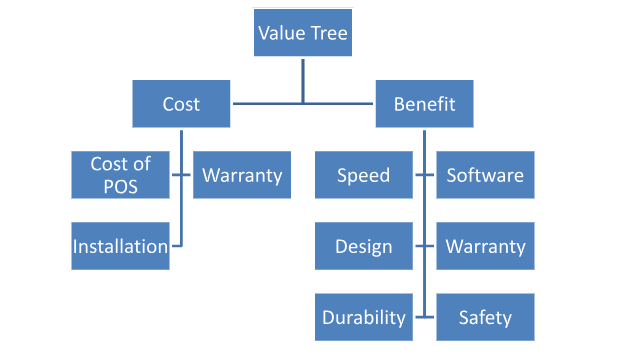
The value tree is categorised into two sections that named as “Cost” and “Benefit”. Every organisation considers these attributes while taking different purchase decisions. In the context of M & S, the attribute of the cost is a breakdown in three sub-categories such as Cost of POS, Warranty cost as well as Installation. This attribute is considered as the most important element in the business decision-making process (Rajasekaran and et al., 2016). Another section of above value tree is a benefit that is categorised in the six subsection such as speed, software, design, warranty, durability and safety. Therefore, the management of Marks & Spencer is able to evaluate several facts and figures as per the goals of the company.
In this section of the SMART approach of the decision making process, evaluation of original and normalised weights is carried out of each attribute as per the preference and requirement of Retail Company. As per interest of M & S, the speed of POS has gained the highest important with the weight of 100. In addition to that software and design have got the weight respectively 90 and 85. Similarly, weights are provided to a lower level of attributes (Greasley, 2017). As per the below-mentioned table, M & S has summarised the original weight of six attributes to 412 and has converted to a total normalised weight of 100. On the basis of total normalised weight, Marks and Spencer can examine the normalised weight of each attribute that has been considered for the attainment of business objectives.
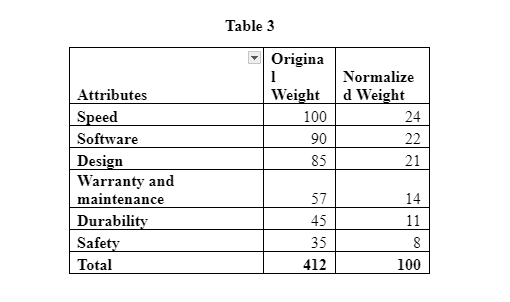
For the Marks & Spencer, the purchase manager has determined six distinct attributes for taking appropriate decision that would offer maximum benefit to the company. It includes Speed, Software, Design, Warranty, Durability and Safety. For each attribute, the business entity has allocated weight according to its importance that is 24 for speed, 22 for software, 21 for design, 14 for Warranty, 11 for Durability and 8 for Safety (Kahraman, Onar and Oztaysi, 2015). With reference to these weights, calculation of aggregated value is carried out of each alternative so as an organisation is able to select the best alternative that would offer the best benefit.
For the Marks & Spencer, the purchase manager has determined six distinct attributes for taking appropriate decision that would offer maximum benefit to the company. It includes Speed, Software, Design, Warranty, Durability and Safety. For each attribute, the business entity has allocated weight according to its importance that is 24 for speed, 22 for software, 21 for design, 14 for Warranty, 11 for Durability and 8 for Safety (Kahraman, Onar and Oztaysi, 2015). With reference to these weights, calculation of aggregated value is carried out of each alternative so as an organisation is able to select the best alternative that would offer the best benefit.
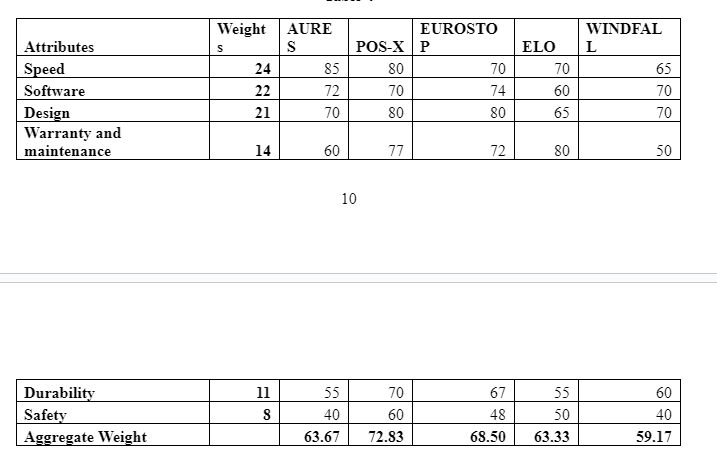
As per the above table, POS-X has got the highest weight and Windfall has got the lowest weight. However, this section has avoided the cost of POS machine of each company. Therefore, it is critical for M & S for considering only attributes of different company’s products.
Trading benefits against cost are considered cost-benefit analysis that is considered as the most important element of business decision-making process in which management tries to assess the highest benefits in lowest cost.

As per the above table and figure, Windfall is offering the cheapest POS machine as compared to others, but it is offering the lowest number of benefits. If a company moves Windfall to AUREX, then the weight is increased by 4 points with the addition to the cost of £35. If a company move from AUREX to EUROSTOP that will enhance weight to 68.5 within the cost of £840. However, consideration of POS-X offers the highest benefit with a rating of 72.83, but it shows increment in cost by £160.
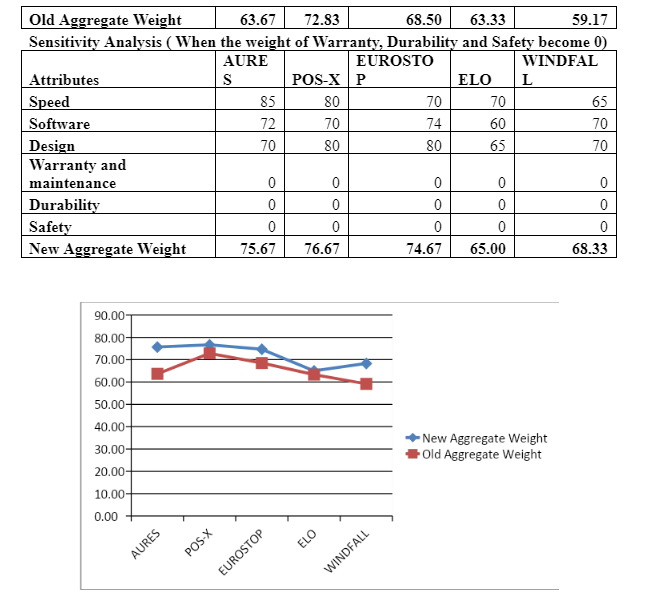
As per the above chart, there is significant change addressed in aggregate weight if the weight of attributes Warranty, Durability and Safety become Zero then highest change is addressed in weight of AURES (Thirathon, Wieder, Matolcsy and Ossimitz, 2017). ELO has recorded the lowest change that is increased to 65. Final Decision As per the above assessment, Marks & Spencer could go for Eurostop and Aures for selecting the point of sales of the machine. However, consideration of Eurostop will offer great returns by meeting expectations of M & S such as quick delivery and increased service rendering process.
STRENGTHS AND LIMITATION OF THIS PROBLEM
The main strength of the decision making process is to examine different attributes as per the requirement of projects along with its preference. Consideration of weight of different attributes of project or business requirements helps the manager for making a systematic comparison of different attributes in very less time duration. In the context of business decision-making process, the business entity is able to manage change in weights and their impact on overall results (Qin, Liang and Wei, 2017). By considering the overall result or weights of different alternatives, top management of Marks & Spencer is able to select the best alternative. In this process, the SMART analysis is being identified as a great tool for analysing several aspects of different attributes that would be found beneficial for the company. In this regards, this approach has considered both quantitative and qualitative criteria (Bohler, Krishnamoorthy and Larson, 2017).
On the contrary, there are some limitations addressed in the SMART analysis. It has addressed the sensitivity analysis not useful for evaluating changes in weight of attribute due to change in the situation. The above decision-making process is only worked on attributes because it does not consider other approaches such as a market image of potential suppliers, brand value and emergence of other technologies (Hair Jr and et al., 2015). All of these factors limited the importance of decision analysis.

CONCLUSION
As per the above assessment, it is concluded that Marks & Spencer is going to replace its old Point of Sales (POS) machines for improving service quality because business entity wants to offer quick services to customers. This report evaluates various alternative options with reference to different tools of decision analysis. In this context, it is concluded that EUROSTOP will be termed as the most suitable company for Marks & Spencer because this company has addressed the highest weight. It will be considered as the most appropriate brand for M & S.
REFERENCE
- Akrani, G., 2011. Importance of Decision Making in Management. [Online.] Accessed Through: [Accessed on 12th Feb. 2019]
- Bagozzi, R.P., Sekerka, L.E. and Sguera, F., 2018. Understanding the consequences of pride and shame: How self-evaluations guide moral decision making in business. Journal of Business Research, 84, pp.271-284.
- Baker, A.J., 2018. Business decision making. Routledge.
- Barlett, P.F. ed., 2016. Agricultural decision making: Anthropological contributions to rural development. Academic Press.
- Bohler, J., Krishnamoorthy, A. and Larson, B., 2017. The Financial and Non-Financial Aspects of Developing a Data-Driven Decision-Making Mindset in an Undergraduate Business Curriculum. e-Journal of Business Education and Scholarship of Teaching, 11(1), pp.85-96.
- Chisholm, R., 2017. Interorganizational decision making. Routledge.
- Collier, P.M., 2015. Accounting for managers: Interpreting accounting information for decision making. John Wiley & Sons.
- De Maio, C., Fenza, G., Loia, V., Orciuoli, F. and Herrera-Viedma, E., 2016. A framework for context-aware heterogeneous group decision making in business processes. Knowledge-Based Systems, 102, pp.39-50.
- Foster, G., O'Reilly, N. and Dávila, A., 2016. Sports business management: Decision making around the globe. Routledge.
- Greasley, A., 2017. Simulation modelling for business. Routledge.
- Hair Jr, J.F., Wolfinbarger, M., Money, A.H., Samouel, P. and Page, M.J., 2015. Essentials of business research methods. Routledge.
- He, W., Wang, F.K. and Akula, V., 2017. Managing extracted knowledge from big social media data for business decision making. Journal of Knowledge Management, 21(2), pp.275-294.
- Janssen, M., van der Voort, H. and Wahyudi, A., 2017. Factors influencing big data decision-making quality. Journal of Business Research, 70, pp.338-345.
- Kahraman, C., Onar, S.C. and Oztaysi, B., 2015. Fuzzy multicriteria decision-making: a literature review. International Journal of Computational Intelligence Systems, 8(4), pp.637-666.
- Macaulay, S., 2018. Non-contractual relations in business: A preliminary study. In The Law and Society Canon (pp. 155-167). Routledge.
- MARKS & SPENCER SELECTS TRUE TO DRIVE DIGITAL INNOVATION AGENDA. 2018 [Online.] Accessed Through:[Accessed on 12th Feb. 2019].
- Potočan, V., 2017. Standardization of business decision-making. Management: journal of contemporary management issues, 5(2), pp.34-50.
- Potočan, V., 2017. Standardization of business decision-making. Management: journal of contemporary management issues, 5(2), pp.34-50.
- Qin, Q., Liang, F., Li, L. and Wei, Y.M., 2017. Selection of energy performance contracting business models: A behavioral decision-making approach. Renewable and Sustainable Energy Reviews, 72, pp.422-433.
- Rajasekaran, K.G., Bhaskar, G.B., Chandrasekaran, M. and Murali, S., 2016. A Review on Employing Multi Criteria Decision Making Methods for Supplier Selection. Asian Journal of Research in Social Sciences and Humanities, 6(6), pp.802-810.
- Thirathon, U., Wieder, B., Matolcsy, Z. and Ossimitz, M.L., 2017, November. Impact of big data analytics on decision making and performance. In International Conference on Enterprise Systems, Accounting and Logistics.
- Wheelen, T.L., Hunger, J.D., Hoffman, A.N. and Bamford, C.E., 2017. Strategic management and business policy. pearson.
Looking for further insights on Counselling and Forensic Psychology? Click here.
- 24/7 Customer Support
- 100% Customer Satisfaction
- No Privacy Violation
- Quick Services
- Subject Experts



